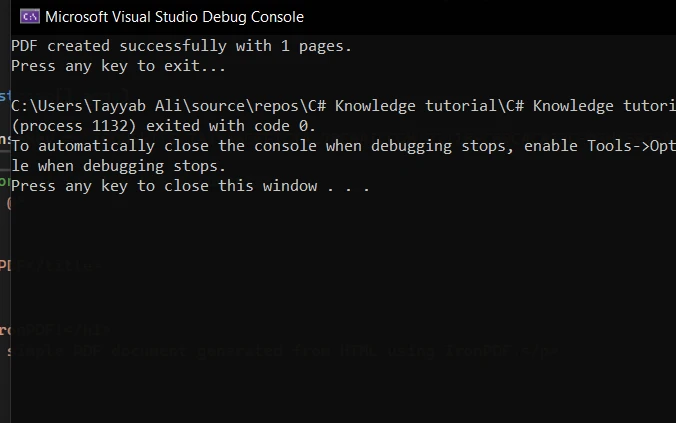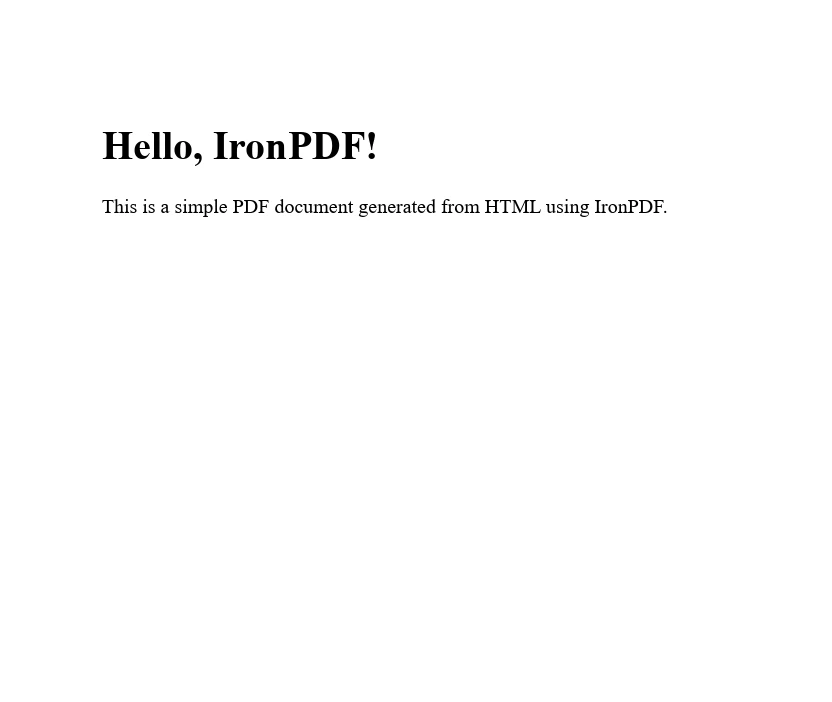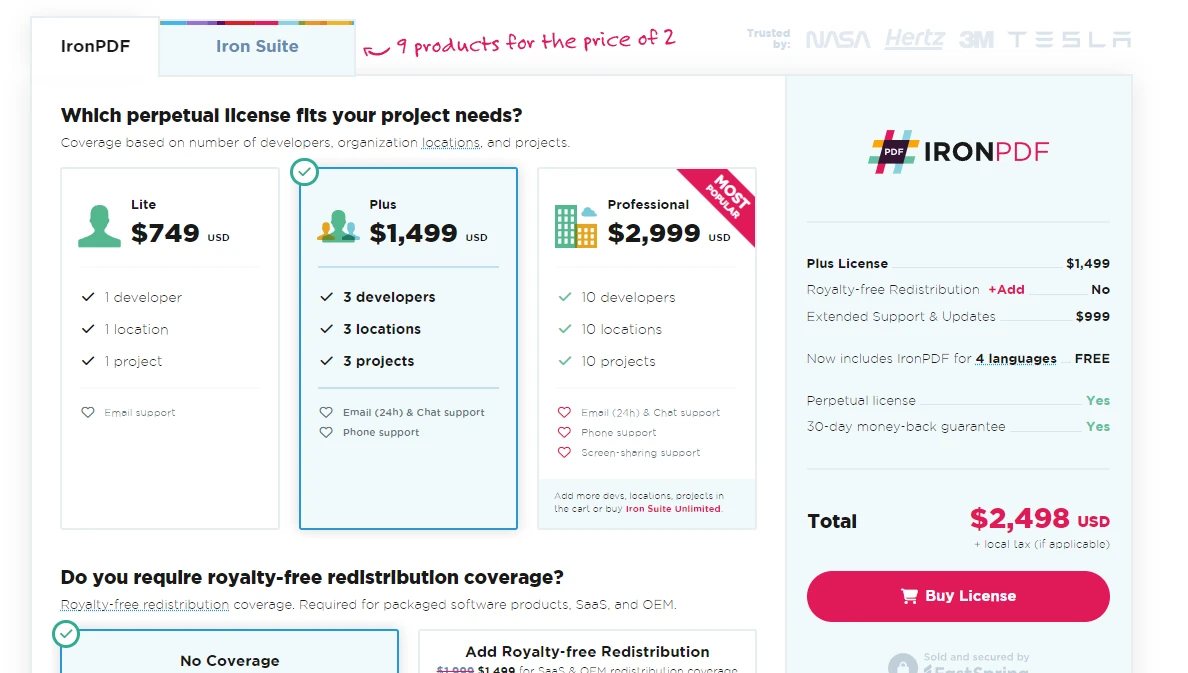Test in production without watermarks.
Works wherever you need it to.
Get 30 days of fully functional product.
Have it up and running in minutes.
Full access to our support engineering team during your product trial
C# Null Conditional operator offers a more concise and safe way to handle null values in your code. The beauty of this operator lies in its ability to simplify null checks, making your code cleaner and more readable.
Let's dive into the specifics of how the null conditional operator works, its benefits, and how you can use it in your projects. We'll also explore IronPDF and its use cases and its use case with the Null conditional operator.
The null conditional operator, often referred to as the "Elvis operator" due to its resemblance to Elvis Presley's hairstyle (?.), allows you to perform member access or method calls on an object only if that object is not null.
If the object is null, the operation returns null instead of throwing a null reference exception. This operator is a game-changer for developers, as it significantly reduces the amount of code needed to safely access members of potentially null objects.
To understand the null conditional operator, consider the public class Employee example. This class might have properties such as public string FirstName and public string LastName. In traditional C# code, accessing a property of a potentially null Employee object requires explicit null checks to avoid exceptions:
if (employee != null)
{
var name = employee.FirstName;
}if (employee != null)
{
var name = employee.FirstName;
}If employee IsNot Nothing Then
Dim name = employee.FirstName
End IfHowever, with the null conditional operator, you can simplify this to one line:
var name = employee?.FirstName;var name = employee?.FirstName;Dim name = employee?.FirstNameIf employee is not null, the name variable receives the value of employee.FirstName. If employee is null, name is set to null. This single line of code thus elegantly replaces multiple lines of explicit null checks.
The null conditional operator becomes even more powerful when combined with the null coalescing assignment operator (??=). The null coalescing operator enables you to specify a default value in case an expression evaluates to null.
For instance, if you want to ensure the name variable has a default value of "Unknown" instead of null, you can write:
var name = employee?.FirstName ?? "Unknown";var name = employee?.FirstName ?? "Unknown";Dim name = If(employee?.FirstName, "Unknown")This code checks if employee is null and then assigns "Unknown" to name if employee.FirstName is null. It elegantly handles null values in one operation, showcasing how concise and effective your code can become.
C# introduced nullable types, which allow variables to hold either a non-null value of their underlying type or null.
When working with collections, the null conditional operator can be used to access an element without risking a null reference exception. Suppose you have a list of employees and want to access the first element's name safely. You can use the operator with square brackets:
var firstName = employees?[0]?.FirstName ?? "Unknown";var firstName = employees?[0]?.FirstName ?? "Unknown";Dim firstName = If(employees?(0)?.FirstName, "Unknown")This line of code is thread-safe, meaning it ensures that if another thread changes employees to null after the null check but before accessing its first element, your code won't crash. When dealing with nullable types, it's important to understand their underlying value type, which is the non-nullable type associated with the nullable type.
One of the subtleties of using the null conditional operator is its thread safety feature. When you use this operator, the evaluation of the expression is thread-safe. This means if you are accessing a shared resource that might be modified by another thread, using the null conditional operator can prevent potential race conditions.
However, it's important to understand that while the operator itself is thread-safe for the operation it performs, it doesn't guarantee thread safety for your entire code block or sequence of operations.
Let's consider a more practical example where you have an object that could raise an event. In traditional C#, you'd check if the event handler is null before invoking the event to avoid a null reference exception:
if (PropertyChanged != null)
{
PropertyChanged(this, new PropertyChangedEventArgs(name));
}if (PropertyChanged != null)
{
PropertyChanged(this, new PropertyChangedEventArgs(name));
}If PropertyChanged IsNot Nothing Then
PropertyChanged(Me, New PropertyChangedEventArgs(name))
End IfWith the null conditional operator, this can be simplified to:
PropertyChanged?.Invoke(this, new PropertyChangedEventArgs(name));PropertyChanged?.Invoke(this, new PropertyChangedEventArgs(name));If PropertyChanged IsNot Nothing Then
PropertyChanged.Invoke(Me, New PropertyChangedEventArgs(name))
End IfThis concise code achieves the same result but in a more readable and safe manner. In scenarios where you want to explicitly return null, you can simply use the return null; statement. The ?. operator short-circuits the operation if PropertyChanged is null, thus preventing an exception. Here is the full code:
using System.ComponentModel;
public class Person : INotifyPropertyChanged
{
private string name;
public event PropertyChangedEventHandler PropertyChanged;
public string Name
{
get { return name; }
set
{
if (name != value)
{
name = value;
OnPropertyChanged(nameof(Name));
}
}
}
protected virtual void OnPropertyChanged(string propertyName)
{
// Using the null conditional operator to safely invoke the event
PropertyChanged?.Invoke(this, new PropertyChangedEventArgs(propertyName));
}
}
class Program
{
static void Main(string [] args)
{
Person person = new Person();
person.PropertyChanged += (sender, e) =>
{
Console.WriteLine($"{e.PropertyName} property has changed.");
};
person.Name = "Iron Software"; // This will trigger the PropertyChanged event
}
}using System.ComponentModel;
public class Person : INotifyPropertyChanged
{
private string name;
public event PropertyChangedEventHandler PropertyChanged;
public string Name
{
get { return name; }
set
{
if (name != value)
{
name = value;
OnPropertyChanged(nameof(Name));
}
}
}
protected virtual void OnPropertyChanged(string propertyName)
{
// Using the null conditional operator to safely invoke the event
PropertyChanged?.Invoke(this, new PropertyChangedEventArgs(propertyName));
}
}
class Program
{
static void Main(string [] args)
{
Person person = new Person();
person.PropertyChanged += (sender, e) =>
{
Console.WriteLine($"{e.PropertyName} property has changed.");
};
person.Name = "Iron Software"; // This will trigger the PropertyChanged event
}
}Imports System.ComponentModel
Public Class Person
Implements INotifyPropertyChanged
'INSTANT VB NOTE: The field name was renamed since Visual Basic does not allow fields to have the same name as other class members:
Private name_Conflict As String
Public Event PropertyChanged As PropertyChangedEventHandler Implements INotifyPropertyChanged.PropertyChanged
Public Property Name() As String
Get
Return name_Conflict
End Get
Set(ByVal value As String)
If name_Conflict <> value Then
name_Conflict = value
OnPropertyChanged(NameOf(Name))
End If
End Set
End Property
Protected Overridable Sub OnPropertyChanged(ByVal propertyName As String)
' Using the null conditional operator to safely invoke the event
RaiseEvent PropertyChanged(Me, New PropertyChangedEventArgs(propertyName))
End Sub
End Class
Friend Class Program
Shared Sub Main(ByVal args() As String)
Dim person As New Person()
AddHandler person.PropertyChanged, Sub(sender, e)
Console.WriteLine($"{e.PropertyName} property has changed.")
End Sub
person.Name = "Iron Software" ' This will trigger the PropertyChanged event
End Sub
End ClassHere is the output of the code:

IronPDF is a versatile library for C# developers that allows you to create, edit, and extract PDF content within .NET applications. This library stands out due to its ease of use and its ability to seamlessly integrate PDF functionalities into any .NET project.
IronPDF’s top feature is converting HTML to PDF with complete style preservation, with full layout and style preservation. It’s a great solution for generating PDFs from web content, including reports, invoices, and documentation. It supports conversion from HTML files, URLs, and HTML strings to PDF files.
using IronPdf;
class Program
{
static void Main(string[] args)
{
var renderer = new ChromePdfRenderer();
// 1. Convert HTML String to PDF
var htmlContent = "<h1>Hello, IronPDF!</h1><p>This is a PDF from an HTML string.</p>";
var pdfFromHtmlString = renderer.RenderHtmlAsPdf(htmlContent);
pdfFromHtmlString.SaveAs("HTMLStringToPDF.pdf");
// 2. Convert HTML File to PDF
var htmlFilePath = "path_to_your_html_file.html"; // Specify the path to your HTML file
var pdfFromHtmlFile = renderer.RenderHtmlFileAsPdf(htmlFilePath);
pdfFromHtmlFile.SaveAs("HTMLFileToPDF.pdf");
// 3. Convert URL to PDF
var url = "http://ironpdf.com"; // Specify the URL
var pdfFromUrl = renderer.RenderUrlAsPdf(url);
pdfFromUrl.SaveAs("URLToPDF.pdf");
}
}using IronPdf;
class Program
{
static void Main(string[] args)
{
var renderer = new ChromePdfRenderer();
// 1. Convert HTML String to PDF
var htmlContent = "<h1>Hello, IronPDF!</h1><p>This is a PDF from an HTML string.</p>";
var pdfFromHtmlString = renderer.RenderHtmlAsPdf(htmlContent);
pdfFromHtmlString.SaveAs("HTMLStringToPDF.pdf");
// 2. Convert HTML File to PDF
var htmlFilePath = "path_to_your_html_file.html"; // Specify the path to your HTML file
var pdfFromHtmlFile = renderer.RenderHtmlFileAsPdf(htmlFilePath);
pdfFromHtmlFile.SaveAs("HTMLFileToPDF.pdf");
// 3. Convert URL to PDF
var url = "http://ironpdf.com"; // Specify the URL
var pdfFromUrl = renderer.RenderUrlAsPdf(url);
pdfFromUrl.SaveAs("URLToPDF.pdf");
}
}Imports IronPdf
Friend Class Program
Shared Sub Main(ByVal args() As String)
Dim renderer = New ChromePdfRenderer()
' 1. Convert HTML String to PDF
Dim htmlContent = "<h1>Hello, IronPDF!</h1><p>This is a PDF from an HTML string.</p>"
Dim pdfFromHtmlString = renderer.RenderHtmlAsPdf(htmlContent)
pdfFromHtmlString.SaveAs("HTMLStringToPDF.pdf")
' 2. Convert HTML File to PDF
Dim htmlFilePath = "path_to_your_html_file.html" ' Specify the path to your HTML file
Dim pdfFromHtmlFile = renderer.RenderHtmlFileAsPdf(htmlFilePath)
pdfFromHtmlFile.SaveAs("HTMLFileToPDF.pdf")
' 3. Convert URL to PDF
Dim url = "http://ironpdf.com" ' Specify the URL
Dim pdfFromUrl = renderer.RenderUrlAsPdf(url)
pdfFromUrl.SaveAs("URLToPDF.pdf")
End Sub
End ClassWhether you're generating reports, invoices, or any document in PDF format, IronPDF provides a comprehensive set of tools to accomplish these tasks efficiently.
Integrating IronPDF into your project to handle PDFs in conjunction with null conditional operators can significantly enhance the robustness of your application. This combination is particularly useful when dealing with PDF content that might be null or when performing operations that could potentially result in a null value.
Let's explore a simple example where we use IronPDF to generate a PDF document from HTML content. We will then use the null conditional operator to safely access the document's properties, illustrating how to handle null values gracefully.
First, you need to add IronPDF to your project. You can do this through NuGet Package Manager:
Install-Package IronPdf
Now write the following code into the program.cs file:
using IronPdf;
using System;
public class PdfGenerator
{
public static void CreatePdf(string htmlContent, string outputPath)
{
// Instantiate the HtmlToPdf converter
var renderer = new IronPdf.ChromePdfRenderer();
// Generate a PDF document from HTML content
var pdfDocument = renderer.RenderHtmlAsPdf(htmlContent);
// Use the null conditional operator to safely access the document's properties
var pageCount = pdfDocument?.PageCount ?? 0;
// Check if the PDF was generated successfully and has pages
if (pageCount > 0)
{
// Save the PDF document to the specified output path
pdfDocument.SaveAs(outputPath);
Console.WriteLine($"PDF created successfully with {pageCount} pages.");
}
else
{
// Handle cases where the PDF generation fails or returns null
Console.WriteLine("Failed to create PDF or the document is empty.");
}
}
public static void Main(string [] args)
{
// Define the HTML content for the PDF document
string htmlContent = @"
<html>
<head>
<title>Test PDF</title>
</head>
<body>
<h1>Hello, IronPDF!</h1>
<p>This is a simple PDF document generated from HTML using IronPDF.</p>
</body>
</html>";
// Specify the path where the PDF document will be saved
// Ensure this directory exists on your machine or adjust the path accordingly
string filePath = @"F:\GeneratedPDF.pdf";
// Call the method to generate and save the PDF document
CreatePdf(htmlContent, filePath);
// Wait for user input before closing the console window
Console.WriteLine("Press any key to exit...");
Console.ReadKey();
}
}using IronPdf;
using System;
public class PdfGenerator
{
public static void CreatePdf(string htmlContent, string outputPath)
{
// Instantiate the HtmlToPdf converter
var renderer = new IronPdf.ChromePdfRenderer();
// Generate a PDF document from HTML content
var pdfDocument = renderer.RenderHtmlAsPdf(htmlContent);
// Use the null conditional operator to safely access the document's properties
var pageCount = pdfDocument?.PageCount ?? 0;
// Check if the PDF was generated successfully and has pages
if (pageCount > 0)
{
// Save the PDF document to the specified output path
pdfDocument.SaveAs(outputPath);
Console.WriteLine($"PDF created successfully with {pageCount} pages.");
}
else
{
// Handle cases where the PDF generation fails or returns null
Console.WriteLine("Failed to create PDF or the document is empty.");
}
}
public static void Main(string [] args)
{
// Define the HTML content for the PDF document
string htmlContent = @"
<html>
<head>
<title>Test PDF</title>
</head>
<body>
<h1>Hello, IronPDF!</h1>
<p>This is a simple PDF document generated from HTML using IronPDF.</p>
</body>
</html>";
// Specify the path where the PDF document will be saved
// Ensure this directory exists on your machine or adjust the path accordingly
string filePath = @"F:\GeneratedPDF.pdf";
// Call the method to generate and save the PDF document
CreatePdf(htmlContent, filePath);
// Wait for user input before closing the console window
Console.WriteLine("Press any key to exit...");
Console.ReadKey();
}
}Imports IronPdf
Imports System
Public Class PdfGenerator
Public Shared Sub CreatePdf(ByVal htmlContent As String, ByVal outputPath As String)
' Instantiate the HtmlToPdf converter
Dim renderer = New IronPdf.ChromePdfRenderer()
' Generate a PDF document from HTML content
Dim pdfDocument = renderer.RenderHtmlAsPdf(htmlContent)
' Use the null conditional operator to safely access the document's properties
Dim pageCount = If(pdfDocument?.PageCount, 0)
' Check if the PDF was generated successfully and has pages
If pageCount > 0 Then
' Save the PDF document to the specified output path
pdfDocument.SaveAs(outputPath)
Console.WriteLine($"PDF created successfully with {pageCount} pages.")
Else
' Handle cases where the PDF generation fails or returns null
Console.WriteLine("Failed to create PDF or the document is empty.")
End If
End Sub
Public Shared Sub Main(ByVal args() As String)
' Define the HTML content for the PDF document
Dim htmlContent As String = "
<html>
<head>
<title>Test PDF</title>
</head>
<body>
<h1>Hello, IronPDF!</h1>
<p>This is a simple PDF document generated from HTML using IronPDF.</p>
</body>
</html>"
' Specify the path where the PDF document will be saved
' Ensure this directory exists on your machine or adjust the path accordingly
Dim filePath As String = "F:\GeneratedPDF.pdf"
' Call the method to generate and save the PDF document
CreatePdf(htmlContent, filePath)
' Wait for user input before closing the console window
Console.WriteLine("Press any key to exit...")
Console.ReadKey()
End Sub
End ClassHere is the console output when you run the program:

And this is the PDF generated by the program:


Integrating IronPDF with null conditional operators in your C# projects can significantly streamline your PDF handling tasks while ensuring your code is safe from null reference exceptions. This example demonstrated the synergy between a powerful PDF library and modern C# language features, enabling you to write cleaner, more maintainable code.
Remember, the key to effectively using these tools lies in understanding their capabilities and applying them judiciously in your projects.
IronPDF provides developers with a complimentary trial offering full support and updates, beginning with a lite license.